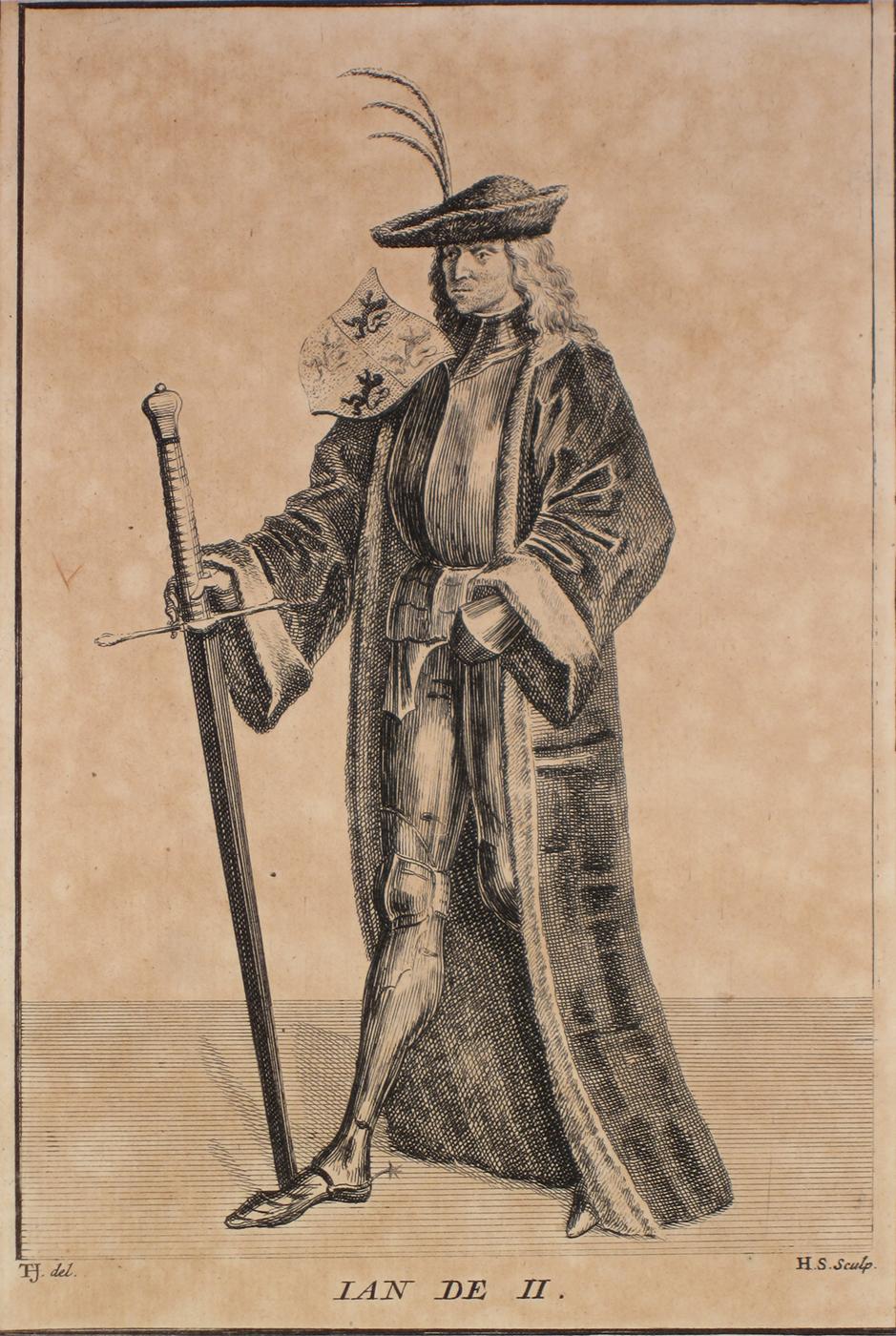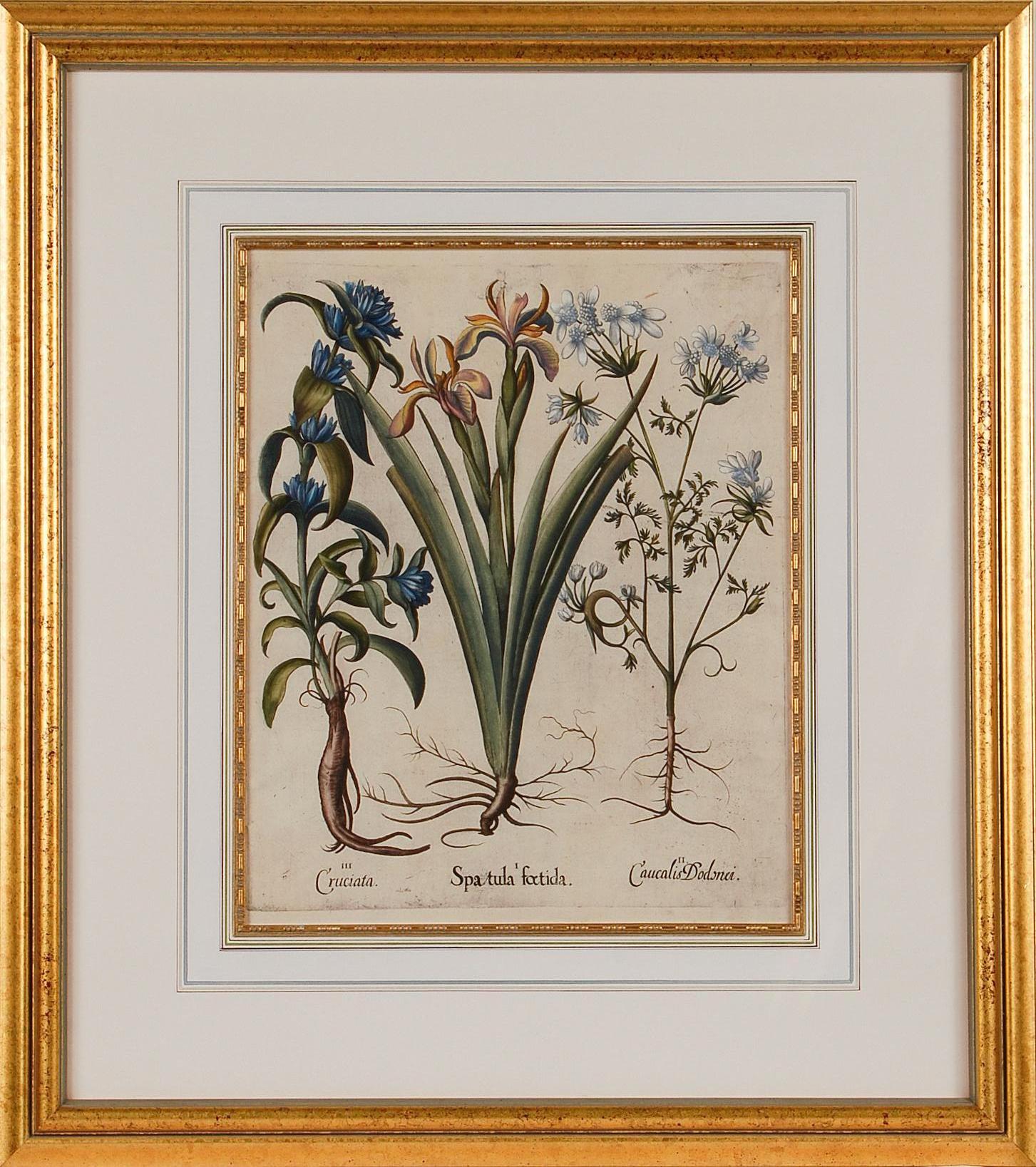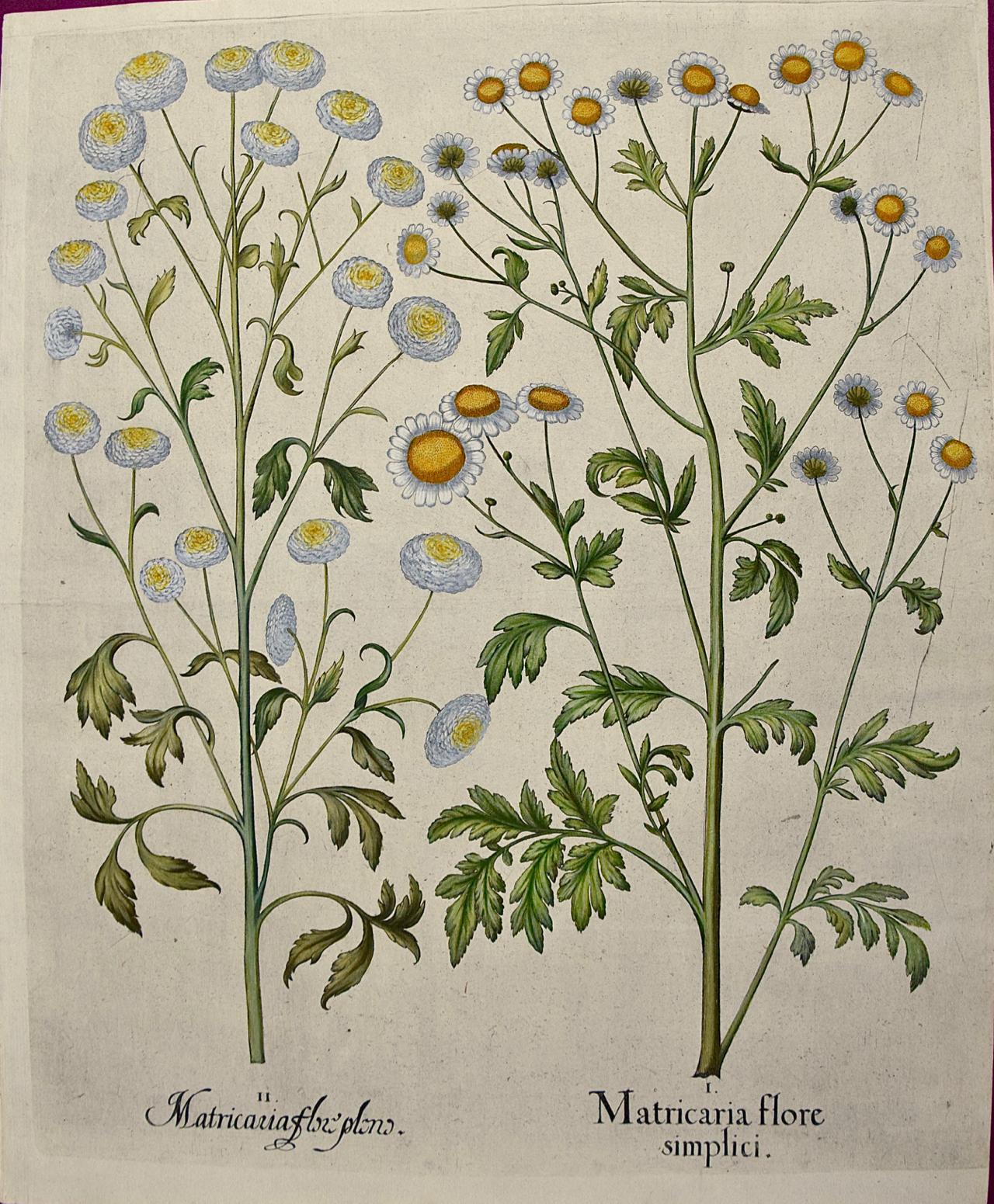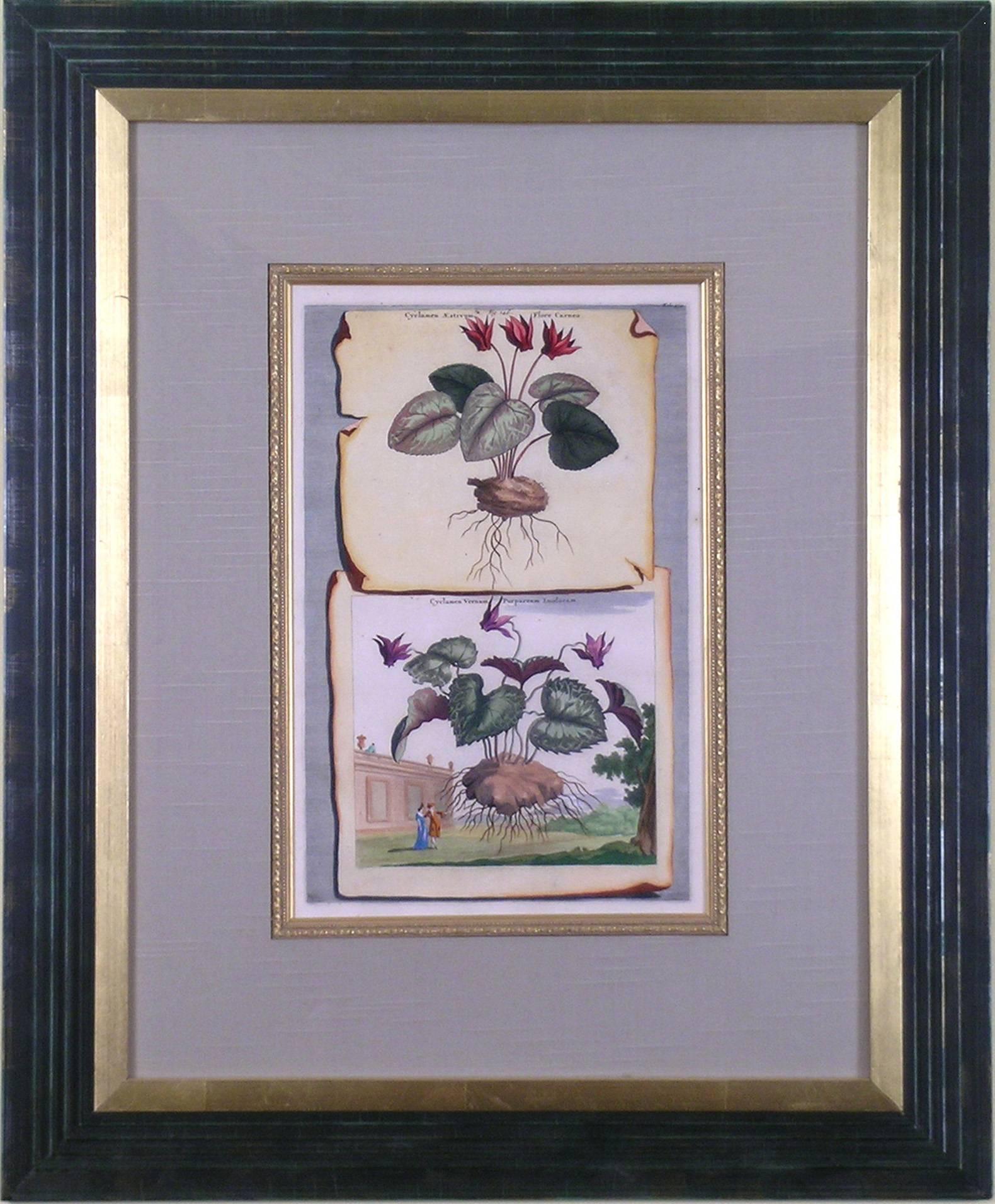Items Similar to Lauro (Laurel)
Want more images or videos?
Request additional images or videos from the seller
Johann Christoph VolkhamerLauro (Laurel)1708
1708
About the Item
JOHANN CHRISTOPH VOLCKAMER (1662-1744).
Nurnbergische Hesperides,
Oder Grunliche Beschreibung der Elden
Citronat, Citronen,und Pomerantzen Fruchte.
Drawn by Decker and Volckamer.
Engraved by Glotsch, Kenckel, Krieger, Montalegre, Pfan and Steinberger.
Engraving with later hand-color.
Nuremberg, 1708.
115 plates Vol I, 132 plates Vol II ( 1714).
Of all fruit-bearing trees, orange and lemon trees were the most attractive to seventeenth and eighteenth century botanists, gardeners, art lovers and painters. Orangeries were tremendously popular--almost every residence, palace, botanical garden and university possessed one--and, exotic and sweet-smelling, they became a favorite area for strolling, painting, and contemplation. Versailles, Fontainebleau and Meudon favored orange, lemon, pomegranate and jasmine grown in pots or wooden tubs placed around their terraces and flower beds. Rare plants and fruits cultivated in conservatories were the pride of their owners and gardeners.
The marvels of these gardens were often recorded to immortalize the successes of the collections. Volckamer, who was a wealthy Nuremberg merchant, had a fine orangery, and engaged a variety of artists and engravers--among the latter being Paul Dedker--to execute his plates, which were uncolored and later finished by hand. The plates are most interesting and unique as the fruit is depicted on a large scale at the top of the plate before a background of a view of a garden, building, landscape or village. Some views of small town gardens show very clearly details of the formal gardens and were valued highly for this information alone. Clearly influenced by Ferrarius, Italy, 1646, the fruit are tied up with ribbons as though for country dances through the streets. Drawn in gouache and watercolor, sometimes on a leafy branch, the ribbons bearing the name of each species were added in the final engravings. Generally the fruit was shown whole or cut in two horizontally to highlight its flesh and seeds. These species, their size, shape, color, frangrance and taste, made them unique and exotic to a world hungry for information of foreign lands.
Truly an extraordinary work, its value is tri-fold: the charming landscapes and architecture; the fruits themselves; and, most notably, their eccentric presentation.
Reference: Great FlowerBooks 1700-1900. Sitwell. Atlantic Monthly Press. NY, 1990.
Flower & Fruit Prints. Dunthorne. Da Capo Press. Washington, D.C., 1938.
- Creator:Johann Christoph Volkhamer (1644 - 1720, German)
- Creation Year:1708
- Dimensions:Height: 24 in (60.96 cm)Width: 20 in (50.8 cm)
- Medium:
- Movement & Style:
- Period:
- Condition:Clean, crisp image. Framed to museum specifications using archival matting, backing, hinging. Linen matting. Glazed with ultra-violet filtering Plexiglas.
- Gallery Location:Florham Park, NJ
- Reference Number:
Johann Christoph Volkhamer
Johann Christoph Volckamer (1644-1720) was a renowned botanical artist whose exquisite illustrations and detailed engravings captured the beauty and intricacy of the plant kingdom. Born in the early 17th century, Johann Volckamer hailed from the city of Nuremberg in Germany. While not much is known about his early life, his passion for botanical art soon propelled him into the realm of fame and recognition. Volckamer's artistic talent and keen eye for detail were evident in his botanical illustrations. He meticulously depicted various species of plants, flowers, and fruits, showcasing their vibrant colors, delicate structures, and natural elegance. His artworks not only possessed aesthetic appeal but also served as valuable scientific records of botanical specimens. One of Volckamer's notable achievements was his renowned work titled "Nürnbergische Hesperides" (Nuremberg Hesperides). Published in the early 18th century, this ambitious project comprised three volumes of meticulously hand-colored copperplate engravings. It showcased a remarkable collection of citrus fruits, including oranges, lemons, and other citrus varieties, as well as accompanying flowers and leaves. The vivid and lifelike depictions of these fruits made the publication highly sought after by collectors, botanists, and horticulturists of the time. Volckamer's botanical illustrations were highly regarded not only for their artistic merit but also for their scientific accuracy. His attention to detail and commitment to capturing the true essence of each plant earned him acclaim within the botanical community. His works were highly regarded by renowned botanists and scholars of the era, including his contemporaries such as Carl Linnaeus. Although much of Volckamer's life remains shrouded in mystery, his contributions to the field of botanical art continue to inspire and captivate art lovers and scientists alike. His artworks serve as a testament to his talent, passion, and dedication to the exploration and celebration of the natural world through the lens of art. Today, Volckamer's works can be found in prestigious art collections and museums, preserving his legacy as a masterful botanical artist.
About the Seller
5.0
Vetted Seller
These experienced sellers undergo a comprehensive evaluation by our team of in-house experts.
1stDibs seller since 2014
161 sales on 1stDibs
Typical response time: 2 hours
- ShippingRetrieving quote...Ships From: Florham Park, NJ
- Return PolicyA return for this item may be initiated within 1 day of delivery.
More From This SellerView All
- Cyclamen (Purple)By Abraham MuntingLocated in Florham Park, NJAbraham Munting (1626 – 1683) Naauwkeurige Beschryving der Aardgewassen Leiden and Ultrech, Germany, 1696 Publishers: Pieter vander Aa and Francois Halma Folio, 15 ¼ “ x 10 ¼ “ ...Category
18th Century and Earlier Academic Still-life Prints
MaterialsWatercolor, Engraving
- Tempio di Romolo, e RemoBy Antonio AquaroniLocated in Florham Park, NJROMA A. Aquaroni. Engraving. Modern Hand-Color. Rome, 1750. Ever wonder what pre-dated the postcard? By the mid-eighteenth century, travel and exploration had become a we...Category
18th Century and Earlier Academic Prints and Multiples
MaterialsWatercolor, Engraving
- Cyclamen (White)By Abraham MuntingLocated in Florham Park, NJAbraham Munting (1626 – 1683) Naauwkeurige Beschryving der Aardgewassen Leiden and Ultrech, Germany, 1696 Publishers: Pieter vander Aa and Francois Halma Folio, 15 ¼ “ x 10 ¼ “ ...Category
18th Century and Earlier Academic Still-life Prints
MaterialsWatercolor, Engraving
- Take Away the Pricks of PleasureBy CLAUDE PARADIN (c1510-1573)Located in Florham Park, NJCLAUDE PARADIN (c1510-1573) Devises Heroiques et Emblemes Woodcut. Paris, 1614. The emblem has played an important role throughout history. Found on ...Category
17th Century Academic More Prints
MaterialsEngraving
- BeansBy Matthäus Merian the ElderLocated in Florham Park, NJMATTHAUS MERIAN, the Elder (1593-1650) Der Fruchtbringenden Gesellschaft Nahmen. Frankfurt, 1646. Engraving with Later Hand-Color. 400 Plates. Image Size 4.5” x 5.25” Unframed. ...Category
18th Century and Earlier Academic Still-life Prints
MaterialsEngraving, Watercolor
- SquashBy Matthäus Merian the ElderLocated in Florham Park, NJMATTHAUS MERIAN, the Elder (1593-1650) Der Fruchtbringenden Gesellschaft Nahmen. Frankfurt, 1646. Engraving with Later Hand-Color. Matthew Merian was one of the most prolifica...Category
18th Century and Earlier Academic Still-life Prints
MaterialsWatercolor, Engraving
You May Also Like
- John II, Count of Hainaut Holland & Zeeland (1247-1304)Located in Sydney, NSW18th Century (c1740) etching/engraving , John II, Count of Hainaut Holland & Zeeland (1247-1304)Category
19th Century Academic Figurative Prints
MaterialsEngraving, Etching
- Flowering Iris & Other Botanicals: Framed 17th C. Besler Hand-colored EngravingLocated in Alamo, CAThis is a hand-colored copper-plate engraving entitled "I. Spatula foetida - II. Caucalis Dodonei - III. Cruciata", depicting three flowering plants, including an Iris, from Basilius Besler's landmark work, Hortus Eystettensis (Garden at Eichstatt), first published in 1613 in Eichstatt, Germany near Nuremberg and later in 1640 and 1713. This beautiful hand-colored botanical engraving is presented in a gold-colored wood frame with a French mat...Category
Mid-17th Century Academic Still-life Prints
MaterialsEngraving
- Flowering Feverfew Plants: A 17th C. Besler Hand-colored Botanical EngravingLocated in Alamo, CAThis is a hand-colored copper plate engraving entitled "Matricaria Flore Simplici, Matricaria Flore Pleno, depicting flowering Feverfew and Double-flowered Feverfew plants, from Basilius Besler's landmark work, Hortus Eystettensis (Garden at Eichstatt), first published in 1613 in Eichstatt, Germany near Nuremberg and later in 1640 and 1713. The feverfew plant is also known as featherfew, featherfoil, or bachelor’s buttons...Category
1640s Academic Still-life Prints
MaterialsEngraving
- Flowering Lily Plants: A 17th C. Besler Hand-colored Botanical EngravingLocated in Alamo, CAThis is a hand-colored copper plate engraving entitled "Cataputia Vulgaris, Parietaria Sylvestris, Nummularia", depicting flowering Spanish Nut, Yellow Turk's-cap Lily, Yellow Turk's...Category
1640s Academic Still-life Prints
MaterialsEngraving
- Flowering Pomegranate & Rock Rose: A 17th C. Besler Hand-colored EngravingLocated in Alamo, CAThis is a hand-colored copper-plate engraving entitled "Cistusflore Albo, Balaustium Flore Minori Romanum, Cotinus", depicting flowering Pomegranate, Rock Rose...Category
1640s Academic Still-life Prints
MaterialsEngraving
- A set of Biblical prints after the Dutch painter and engraver Gerard HoetBy Gerard HoetLocated in London, GBThe present collection is a set of 131 prints after Gerard Hoet, the Dutch golden age painter and engraver, depicting various biblical scenes. Hoet was a leading artist in the Classicizing Dutch Academic style, and his work is defined by history paintings, with a particular interest in mythological, classical, historical, and biblical scene, in particular Old testament scenes...Category
Early 1700s Academic Figurative Prints
MaterialsInk, Paper, Black and White, Engraving






